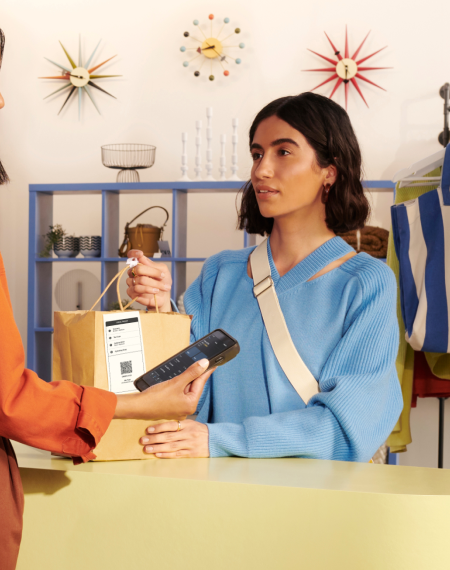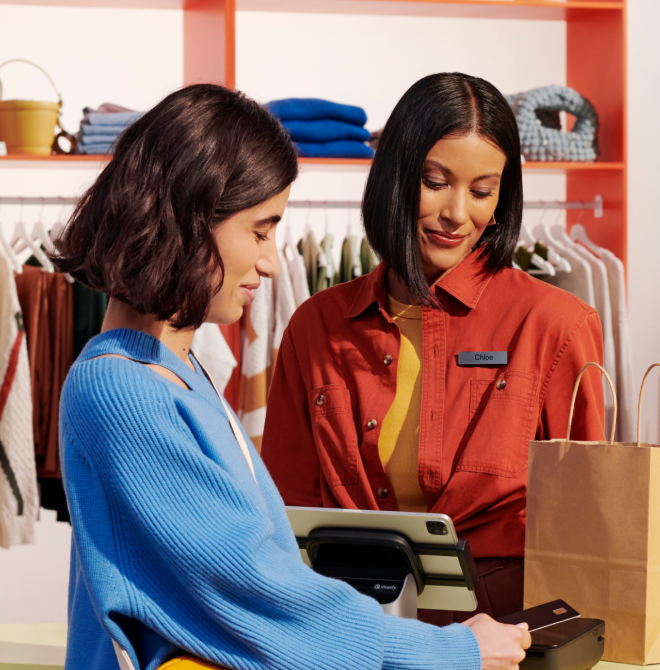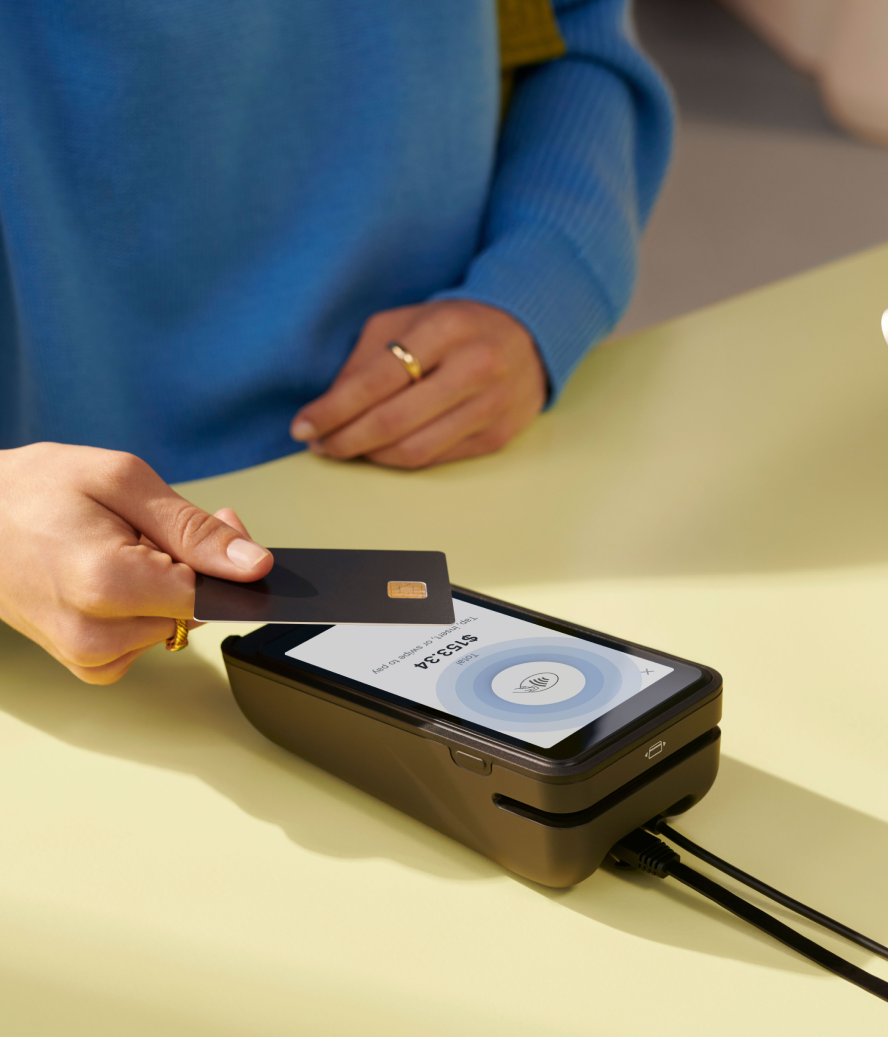Few industries are as competitive as apparel retail. Based on Shopify’s ecommece data, Apparel retail leads ecommerce growth across every major market—from North America to Asia-Pacific. It's the top industry by order volume for million-dollar brands, outpacing even fast-growing sectors like health and beauty and home and garden.
At the same time, 80% of shoppers expect to spend the same or less on apparel by 2025. To stay competitive, brands need to deliver better experiences while keeping costs in check. Leading retailers are discovering that the answer isn't connecting more systems—it's simplifying their technology. And that starts with their point-of-sale (POS) system.
We'll break down how to choose the right POS for your apparel business, with a focus on solutions that naturally bring your online and in-store operations together. Whether you're opening your first store or expanding to new locations, this guide will help you build the right foundation for growth.
5 best apparel POS systems
We’re firm believers that the best POS systems act as a central operating system for every part of your business. Shopify is the only platform to natively unify POS and ecommerce, hence why we’re recommending it as the best option for clothing stores.
That said, we know it’s useful to compare your options. Here are five of the best apparel POS vendors ranked by their features, use cases, and pricing options.
1. Shopify
With its native omnichannel capabilities, Shopify is more than just a POS solution—it’s a robust operating system that equips apparel brands with the tools and features they need to deliver exceptional shopping experiences at scale.
Shopify is used by leading apparel brands including Gymshark, Good American, and SKIMS. It offers a comprehensive suite of features for scaling retailers—and with its user-friendly interface, even your newest trainee staff members will be POS pros in no time.
It’s easy to see why: 75% of shoppers say they’re likely to spend more after receiving high-quality service in-store, which makes a unified POS that ties online and offline data together even more vital. Whether you’re handling in-person styling appointments or fulfilling online orders from store inventory, a single source of truth can help elevate the shopping experience.
In a survey of 1,000 Shopify POS customers, the majority of Apparel & Accessories customers agree Shopify POS increases operational efficiency—and 69% amount say it’s easier to use than their previous POS system.
Best features include:
- Sales channel integrations
- Unified customer profiles
- Real-time inventory management
- Staff management tools
- Unlimited products and SKUs
- Intuitive checkout
- Range of POS hardware, including barcode scanners and receipt printers
- Native payment processing
- Tap to Pay to accept payments on-the-go
- Detailed reporting and analytics
- Over 8,000 prebuilt apps
“With Shopify, there is so much money and development effort saved by utilizing a system that can take care of retail and ecommerce,” says Edwin Portillo, VP of technology at Good American. “I think that’s the beauty of it.”
Pricing: From $29 per month. Payment processing fees start at 2.6% + 10¢ for in-person transactions and 2.9% + 30¢ for online payments. There is a free trial available.
2. Lightspeed Retail
Lightspeed is a POS company that caters to apparel retailers. It offers inventory management, native payment processing, and an ecommerce integration, with the option to manage multiple locations from the same POS system.
Best features include:
- Ecommerce integration
- Real-time sales reporting
- Customer database
- Integrated payments
- Supplier and inventory management
Pricing: Plans start at $89 per month for one POS register. Payment processing rates are a little more tricky to calculate. It estimates that retailers who process between $5,000 and $34,999 per month will spend $200 on transaction fees.
💡Learn: How Mister Zimi Outgrew Lightspeed POS and Unified its Sales Channels
3. Square POS
Square’s POS system is designed for small to midsized businesses. Clothing retailers can use the system to offer in-store pickup and local delivery, track inventory in real-time, and sell online. It’s an affordable option, but bear in mind that some features come at an additional cost to the standard monthly subscription.
Best features include:
- Low stock alerts
- In-store pickup and delivery
- Staff management tools
- Option to secure funding
- Customer loyalty programs
Pricing: Square offers a free plan where processing rates start at 2.6% + 15¢ for card present in-person sales transactions. Premium features, such as email marketing and loyalty programs, come at an additional cost.
4. PayPal Zettle
Zettle is a POS system that’s part of the PayPal ecosystem. It offers a wide range of POS hardware, from mobile card readers to fixed countertop terminals. Apparel brands using the Zettle POS system benefit from fast payouts to their PayPal business account balance.
Best features include:
- Fast payouts
- Range of POS hardware
- Gift card management
- Product and category management
- Shopify integration available
Pricing: There’s no hardware rental fee if you’re using the PayPal Zettle POS app on your smartphone. There is a 2.29% + 9¢ transaction fee per card present transaction.
5. Revel Systems
Revel Systems, now part of the Shift4 group, is a cloud-based POS software that can turn your existing hardware—such as your smartphone or iPad—into a POS system. It offers self-service kiosks, loyalty programs, and a customer display system to give retail staff the tools they need to sell to customers.
Best features include:
- Automatic stock alerts
- Customizable discounts
- Comprehensive reporting and analytics
- Secure payment processing
- Split-bill functionality
- Customizable user permissions
Pricing: Revel Systems doesn’t share its pricing publicly. You’ll need to contact the Shift4 sales team for a custom quote.
Apparel POS features
Sales channel integration
Today’s consumers expect to shop with their favorite brands on multiple channels—whether that’s a retail store, ecommerce website, online marketplace, social media storefront, or mobile app. Check that your POS system integrates with these platforms to offer seamless experiences for customers.
Unified commerce takes this a step further by simplifying the backend operations of operating an omnichannel business. When inventory, customer, and sales data comes from the same commerce platform, you can:
- Sync product data—such as pricing, imagery, and product descriptions—to every sales channel.
- Manage orders from a single order management system.
- Offer omnichannel returns and exchanges, regardless of where the order was initially placed.
It’s no wonder why Shopify POS delivers 22% better total cost of ownership on average compared to major global POS competitors.

Centralized data and CRM
Despite the rise of online shopping, 40% of consumers primarily buy apparel and footwear in-store—underscoring the need for in-store experiences that stand out. Meanwhile, 18% of all social commerce transactions come from apparel, making it the largest category across social channels.
Shopify’s clothing store POS system creates customer profiles whenever someone shares their email address or phone number with your business. Any supplementary data you collect, whether through a Shopify feature (such as their order history) or an app integration (like an email marketing tool) feeds back to this unified profile.
Sales associates can reference this data to personalize the in-store experience. For example, you might see that a shopper has bought a dress in a size 10 and has recently clicked a yellow midlength dress in a recent email marketing campaign. Use this insight to recommend other yellow dresses that are in stock in a size 10.
Targeted discounts and loyalty programs
Loyalty programs convince customers to continue shopping with your store. This steady stream of repeat purchases can serve as a lifeline for apparel stores—you don’t have to rely on shiny new marketing campaigns to drive foot traffic.
Check that your POS system offers native loyalty programs that work across every sales channel. For example, with the Smile app for Shopify, customers can earn loyalty points and redeem rewards on online and in-person purchases.
💡Tip: Shopify’s POS UI integrations let cashiers tap the loyalty program tile on their Smart Grid to quickly award or redeem loyalty points on in-store purchases.

Flexible checkout options
Speedy checkout helps you serve more customers in less time. It also impacts the customer experience: shoppers are unlikely to return if the checkout process is clunky, or they can’t use their preferred payment method.
For apparel brands, this is critical because apparel has one of the highest return rates of any retail sector, and a flexible checkout (both online and in-store) reduces friction if returns or exchanges are needed later.
Shopify POS lets customers pay for orders using:
- Cash
- Credit and debit cards
- Mobile wallets, such as Apple Pay and Google Pay
- Buy now, pay later through Shop Pay Installments
- Loyalty points through your POS loyalty program
- Gift cards
This doesn’t just apply to new purchases—the fashion industry faces one of the highest return rates of all. Check that your apparel POS system can handle omnichannel returns. If a customer purchases an item through your online store, for example, they should be able to return it in-store (and vice versa).
“We adopted Shopify for what it does best: the smooth processing of orders, exchanges, and returns, as well as its efficient payment process,” says Benjamin Mateo, chief revenue officer at loungewear brand Asphalte.
Endless aisles
Apparel brands stock multiple variations of the same product. Whether it’s different sizes, colors, or styles, it’s not always feasible to have multiples of every variation available for customers to take home.
The endless aisle concept treats your apparel store as a mini showroom. Customers can visit your retail store to browse your catalog, try on options, and interact with clothing in the flesh. You can then use the POS system to ship the order to the customer’s home from a separate fulfillment location—like a bigger nearby store or your retail warehouse.
Multiple fulfillment methods
In the intensely competitive apparel industry, the ability to create a memorable and engaging in-store experience is no longer a luxury—it’s a necessity. Customers look for flexibility in how they make their purchases.
Cater to these omnichannel demands with alternative fulfillment methods such as:
- Buy online, pickup in-store (BOPIS): Simplify your in-store pickup operations, streamline customer experiences, and track inventory by managing and fulfilling BOPIS orders directly from your Shopify POS admin.
- Ship to customer: Customers can buy in store and ship to their homes with the order routed to the appropriate store for the retailers’ tracking. This reduces unnecessary shipping costs and product delays.
- Outsourced fulfillment: Prefer to outsource fulfillment to a third-party logistics partner? Use the Shopify Fulfillment Network to connect your order management system with Flexport, who will store and fulfill orders whenever you receive them.
Vestique is just one apparel brand already using these features in Shopify POS. It uses physical store locations as fulfillment centers for online orders—a move that’s helped increase overall sales by 18% and assist with the speedy opening of three new locations.
Real-time inventory updates
Effective inventory management is crucial for any apparel business. This is especially true when dealing with factors like seasonal fluctuations in demand, color and size variations, and supply chain disruptions. Empty shelves lead to lost sales and overstocking is simply wasted money.
Check that your apparel POS system offers real-time inventory tracking across every storage and sales location. Shopify, for example, has reporting and analytics features to generate data like:
- Product reports: Get insights to understand product-level performance.
- Discount reports: Track the performance of your promotions so you can evolve your approach over time.
- Cash flow reports: Understand how much you’ll be paid and when you’ll receive your money from in-person and online sales.
💡Tip: Install the Stocky app to add extra inventory management functionality to your apparel POS system. Track bestsellers, conduct stock takes, and raise purchase orders with suppliers from the POS system your team already knows and loves.

User-friendly, customizable POS interface
It’s easy to dive feet first into your search for a new POS system and opt for one with all the bells and whistles. But some vendors prioritize impressive features over usability. Check that yours offers a sleek, user-friendly interface that’s easy to train staff on.
Shopify, for example, has a customizable Smart Grid. Create shortcuts to your most used tasks—such as bestselling products or discount apps through POS UI integrations—to speed up checkout and make it easier for cashiers to complete orders.
“To get a store fully operational on Shopify and to have Shopify POS on every device takes less than a day," says Tyler Muzzy, director of retail at BLYT Basics. "The setup and training process has been one of the best we’ve experienced since opening up retail.”
Role-based permissions and tracking
Your apparel POS system holds a wealth of data you don’t want to fall into the wrong hands. Whether it’s supplier information or customer credit card details, role-based permissions ensure that this data is kept safe. Only those with the appropriate credentials can complete specific tasks on the POS system.
If you’re rewarding retail staff with commission on any product they sell, check that your apparel POS system can track sales by cashier. With Shopify, for example, you can give each employee a unique PIN-protected login. The POS system automatically tracks orders placed using their account to accurately track performance and award commission—without manual calculations and clunky spreadsheets.

Apparel POS case studies
Mizzen+Main
Menswear retailer Mizzen+Main has been an omnichannel brand since its inception. Yet the logistics of operating an omnichannel retail business became a challenge. Its retail stores had a smaller footprint than traditional stores, which limited the inventory it could hold. The team needed real-time access to accurate inventory data.
Customers shopping for a gift also had limited knowledge on the clothing it sold. It’s critical for sales associates to offer their product knowledge and guide gift-givers towards a purchase by way of a personalized recommendation.
With Shopify, Mizzen+Main could create unified customer profiles to offer personalized shopping experiences. “We open a customers’ profile and can see their full purchase history, which helps us make the right recommendations,” says store manager Trey Pritchard.
The apparel brand’s newfound ability to unify inventory data also lets retail staff check inventory levels at nearby stores. If one SKU is unavailable to take home same-day, cashiers can use ship-to-home to have it shipped directly from the brand’s warehouse to a customer’s home address.
Since switching to Shopify, Mizzen+Main has seen incredible results. Retail revenue grew 27% year-on-year, while online revenue grew 15%.
Good American
Inclusive denim brand Good American started out as a digital-native brand. In a bid to strengthen relationships with customers and offer branded experiences, it expanded into physical retail with the help of Shopify.
Good American integrated Shopify with NetSuite ERP, streamlining inventory and sales tracking. “Retail relies a lot on the existing systems of the business,” says Edwin Portillo, VP of Technology at Good American. “We needed to ensure that bringing on this new sales channel wouldn’t interrupt what we already had in place and that we had all the hardware to support the purchases, inventory transfers, and returns.”
Since opening the doors to its first retail location, Good American has seen measured high levels of customer satisfaction—averaging a 91.69 Net Promoter Score (NPS) in stores. In-store return rates were also 20% lower than ecommerce, while also enhancing operational visibility through its ERP integration and multi-channel attribution capabilities.
Kenny Flowers
After nearly a decade as an online-only apparel brand, Kenny Flowers expanded into physical retail with the help of Shopify POS.
But as a resort wear brand with seasonal fluctuations, founder Kenny says: “When a customer comes into the store, it's either the beginning of a new customer journey or an exciting touchpoint for existing customers. We needed a system that could support both scenarios seamlessly, while also helping us manage the seasonal nature of our business."
A loyalty program underpins the brand’s strategy by encouraging customers to shop year-round. The expansion into retail needed to be seamless: customers must be able to earn and redeem loyalty points wherever they shop.
The speedy implementation of Shopify enabled Kenny Flowers to offer these omnichannel experiences. "When an Island Society member visits the store, their online account is linked automatically," says Kenny. "This gives them access to their benefits and makes it easy to make exchanges or returns, whether they bought online or in-store."
Since expanding its loyalty program in retail, Kenny Flowers experienced 75% year-on-year growth in-store sales. Some 80% of in-store orders come from new customers, and the personalized approach has helped the apparel brand gain up to an additional 20% total revenue through its flagship store.
Grow your apparel business with Shopify POS
Shopify POS is an indispensable tool that empowers apparel merchants of all sizes to grow and scale with ease. With a streamlined platform for inventory management, enhanced customer experiences, unified omnichannel selling, data-driven insights, and seamless marketing tools, Shopify puts the power in your hands.
Say goodbye to checkout chaos and confidently navigate the ever-changing retail landscape with a smoother and more memorable selling experience.
Apparel POS FAQ
What is a clothing store point of sale?
A clothing point of sale (POS) is a system that retailers use to operate their store. It helps retail staff ring up orders, manage inventory, track customer data, process payments, and generate sales reports.
What does POS stand for in clothing?
POS stands for point-of-sale. Clothing retailers use POS systems to operate every part of their store—from tracking inventory and referencing customer data to ringing up orders and processing payments.
What is POS in the fashion industry?
Retailers in the fashion industry use point-of-sale (POS) systems to manage their business. POS systems are the combination of hardware and software that lets fashion brands manage inventory, ring up orders, process payments, initiate returns, and collect customer data.
Which inventory system is most used in clothing stores?
- Shopify
- Lightspeed Retail
- Square POS
- PayPal Zettle
- Revel





